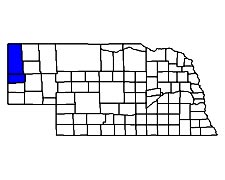
| Cicindela nebraskana Casey |
| Adult Length: 14 to 16.5 mm |
| Appearance: Adults are entirely shiny black on both the dorsal and ventral surfaces. Rare individuals might have two tiny whitish dots present on the elytra, but normal Nebraska specimens are entirely immaculate. Males can be distinguished from females by their white labrum; that of the female is blackish. |
| Similar Species: This species could be confused with the black morph of C. purpurea audubonii or with C. longilabris. It differs from both species by its shiny luster and lack of maculation on the dorsal surface. Though C. longilabris may be immaculate on very rare occasions, the dorsal surface is not shiny, and it is unlikely that any Nebraska collector would encounter it. |
| Biology: This species occurs in short-grass prairie habitats. In Nebraska it appears to be restricted to relatively high altitudes, with most collections occurring above 1460 meters (4800 feet) in elevation. Here it may be found among bare soil patches, trails, dirt roads, and cow paths on hard-packed loamy soils. In the western United States it has been collected at elevations well in excess of 3048 meters (10,000 feet). Adults are relatively skittish and some individuals may fly for over 30 meters when alarmed, especially under windy conditions. |
| Adult Life History: Adults emerge from the pupa mostly from late July to mid-August and may be active well into September before overwintering. Activity resumes in April, with peak numbers from mid-April to mid-May. Numbers decline gradually in summer and adults are probably rare by July. It is a spring-fall species. |
| Larval Life History: The larval life history of this species is unrecorded. Larvae likely occur among bare patches and along trails in short-grass prairies in loamy soil. Larval development likely requires three years. |
| Biogeography: This species has only been recorded from a handful of sites in Sioux and Scotts Bluff Counties in Nebraska. Most collections have occurred in the highlands of the Pine Ridge and the Wildcat Hills. In 2004, a relatively large population was uncovered in the Pine Ridge, and a smaller one was found in the Wildcat Hills. There are doubtless other populations, especially in the Pine Ridge. In North America it is mostly a western species and it occurs from central British Columbia and Saskatchewan to eastern North Dakota, southern Colorado (possibly into New Mexico), southern Utah, and southern California. It is primarily a species of high elevation and becomes more restricted by elevation toward the southern parts of its range. Though most authors only recognize the nominate form, ssp. chamberlainii has previously been described from Steens Mountain in Oregon. There is also some debate about the brownish colored variants of C. nebraskana, and some consider it a subspecies of C. longilabris, ssp. oslari. There is also the possibility that these brown forms may represent yet another species. No brownish colored specimens have been collected in Nebraska. |


